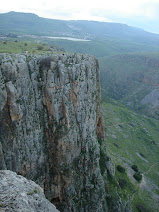Though I couldn't visit Merton's hermitage (it was being used as a retreat for a brother), I desperately wanted to see the "statues." My first attempt to find the statues was a failure, but after talking to Bro. Seamus, I got directions (and a walking map), and set out again. It was quite a walk on a winding path through the woods. As I walked, listening to the sounds of the jar flies and crickets, I was immediately transported to my childhood when I would tromp through the woods near my grandparent's house. It was a soul filling time, and I felt my stores of "silence" begin to fill up a little.
Finally, I reached the statues. A nearby plaque lets the pilgrim know the history of the statues. In 1965, a twenty-six year old Episcopalean seminarian from New Hampshire named Jonathan Daniels went to Alabama to aid in the civil rights movement. He was killed in August of 1965 by white supremacists. The statues depict the Garden of Gethsemane and remember his martyrdom.

The statues are impressive. You first encounter the life-size representations of the disciples sleeping. Then after about 20 more yards, you find Jesus praying in the garden. I have often been troubled by common representations of Jesus in the Garden. Too often, we see a Jesus serenely looking to heaven, at peace with the road that leads to the cross. Yet in Matthew, Jesus told the disciples in the Garden, "My soul is very sorrowful, even to death." The Jesus of the Abbey of Gethsemani doesn't suffer the common misrepresentation. The artist brilliantly conveys the agony of Christ in the Garden while the disciples sleep. You can see the sorrow of Jesus in that place.
I sat there looking at the statue and pondering the night before Jesus was crucified. I thought about the disciples. I thought about Jesus. I thought about the difficulty of walking a road that you know God has called you to—even when you don't want to. It was a nice moment of reflection.

Then something happened that I didn't anticipate. I sat there looking at the agony of Jesus, and I remembered the reason for this garden. I thought of that martyred young man—killed because he believed that everyone is created in the image of God and everyone deserves respect because of that. I thought of that injustice, and I saw Christ in agony over that—and the disciples are still sleeping. Of course, immediately, I came under conviction. How many injustices—how much sorrow is in this world? How often am I sleeping through it? The Sudan—Zimbabwe—or the hungry in my town—how often is God in agony over their suffering? How often am I sleeping right nearby?
Nicholas Wolterstorff hypothesized in his book, Lament for a Son, that the reason no one can look on the face of God is because no one could bear the agony on the face of the divine as God looked on this world. Sitting in that remembrance of the Garden, I felt the tears of God for this world. I pray that I do a better job staying awake and crying some of my own.


1 comment:
It's always good to read what you wrote.
Don't make it so long!
Post a Comment